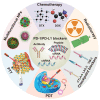Recent Advances in Nanoparticles-Based Platforms Targeting the PD-1/PD-L1 Pathway for Cancer Treatment
- PMID: 36015206
- PMCID: PMC9414242
- DOI: 10.3390/pharmaceutics14081581
Recent Advances in Nanoparticles-Based Platforms Targeting the PD-1/PD-L1 Pathway for Cancer Treatment
Abstract
Immune checkpoint inhibitors (ICIs) targeting the PD-1/PD-L1 axis showed remarkable improvements in overall response and patient survival, which changed the treatment landscape for multiple cancer types. However, the majority of patients receiving ICIs are either non-responders or eventually develop secondary resistance. Meanwhile, immunological homeostasis would be destroyed as T cell functions are activated excessively, leading to immune-related adverse events (irAEs). Clinically, a large number of irAEs caused by ICIs occurred and affected almost every organ system, resulting in the discontinuation or even the termination of the ongoing therapy. Therefore, researchers are exploring methods to overcome the situations of insufficient accumulation of these drugs in tumor sites and severe side effects. PD-1/PD-L1-targeted agents encapsulated in nanoparticles have emerged as novel drug delivery systems for improving the delivery efficacy, enhancing immune response and minimizing side effects in cancer treatment. Nanocarriers targeting the PD-1/PD-L1 axis showed enhanced functionalities and improved the technical weaknesses based on their reduced off-target effects, biocompatible properties, multifunctional potential and biomimetic modifications. Here, we summarize nanoparticles which are designed to directly target the PD-1/PD-L1 axis. We also discuss the combination of anti-PD-1/PD-L1 agents and other therapies using nanomedicine-based treatments and their anticancer effects, safety issues, and future prospects.
Keywords: PD-1/PD-L1; cancer immunotherapy; delivery nanoplatforms; immune checkpoint; nanoparticles.
Conflict of interest statement
The authors declare that the research was conducted in the absence of any commercial or financial relationships that could be construed as a potential conflict of interest.
Figures


Similar articles
-
New insight in endocrine-related adverse events associated to immune checkpoint blockade.Best Pract Res Clin Endocrinol Metab. 2020 Jan;34(1):101370. doi: 10.1016/j.beem.2019.101370. Epub 2019 Dec 11. Best Pract Res Clin Endocrinol Metab. 2020. PMID: 31983543 Review.
-
PD-1/PD-L1 Blockade Therapy in Advanced Non-Small-Cell Lung Cancer: Current Status and Future Directions.Oncologist. 2019 Feb;24(Suppl 1):S31-S41. doi: 10.1634/theoncologist.2019-IO-S1-s05. Oncologist. 2019. PMID: 30819829 Free PMC article. Review.
-
Alternative Strategies for Delivering Immunotherapeutics Targeting the PD-1/PD-L1 Immune Checkpoint in Cancer.Pharmaceutics. 2024 Sep 7;16(9):1181. doi: 10.3390/pharmaceutics16091181. Pharmaceutics. 2024. PMID: 39339217 Free PMC article. Review.
-
Factors affecting tumor responders and predictive biomarkers of toxicities in cancer patients treated with immune checkpoint inhibitors.Int Immunopharmacol. 2020 Aug;85:106628. doi: 10.1016/j.intimp.2020.106628. Epub 2020 May 28. Int Immunopharmacol. 2020. PMID: 32474388 Review.
-
The Inconsistent and Inadequate Reporting Of Immune-Related Adverse Events in PD-1/PD-L1 Inhibitors: A Systematic Review of Randomized Controlled Clinical Trials.Oncologist. 2021 Dec;26(12):e2239-e2246. doi: 10.1002/onco.13940. Epub 2021 Aug 31. Oncologist. 2021. PMID: 34396642 Free PMC article.
Cited by
-
Immune checkpoint inhibitors promising role in cancer therapy: clinical evidence and immune-related adverse events.Med Oncol. 2023 Jul 15;40(8):243. doi: 10.1007/s12032-023-02114-6. Med Oncol. 2023. PMID: 37453930 Review.
-
Tumor Microenvironment Regulation and Cancer Targeting Therapy Based on Nanoparticles.J Funct Biomater. 2023 Feb 28;14(3):136. doi: 10.3390/jfb14030136. J Funct Biomater. 2023. PMID: 36976060 Free PMC article. Review.
-
Clinical updates on tyrosine kinase inhibitors in HER2-positive breast cancer.Front Pharmacol. 2022 Dec 12;13:1089066. doi: 10.3389/fphar.2022.1089066. eCollection 2022. Front Pharmacol. 2022. PMID: 36578543 Free PMC article. Review.
-
Wrecking neutrophil extracellular traps and antagonizing cancer-associated neurotransmitters by interpenetrating network hydrogels prevent postsurgical cancer relapse and metastases.Bioact Mater. 2024 May 14;39:14-24. doi: 10.1016/j.bioactmat.2024.05.022. eCollection 2024 Sep. Bioact Mater. 2024. PMID: 38783926 Free PMC article.
-
Macrophage-inherited exosome excise tumor immunosuppression to expedite immune-activated ferroptosis.J Immunother Cancer. 2023 May;11(5):e006516. doi: 10.1136/jitc-2022-006516. J Immunother Cancer. 2023. PMID: 37192783 Free PMC article.
References
Publication types
Grants and funding
- 19411971100/Science and Technology Commission of Shanghai Municipality
- 81874036 and 82072568/National Natural Science Foundation of China
- SHDC12020110/Shanghai Shenkang Hospital Development Center,
- 82022033/National Outstanding Youth Science Fund Project of National Natural Science Foundation of China
- 19QA1406800/Shanghai Rising-Star Program
LinkOut - more resources
Full Text Sources
Research Materials

